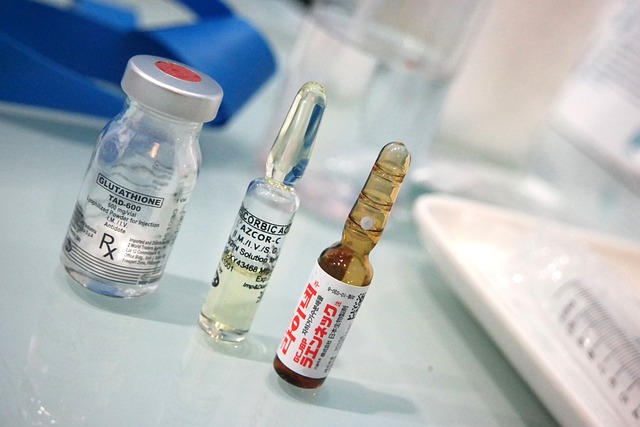Semaglutide, a GLP-1 receptor agonist, offers a once-weekly injectable form for diabetes management, superior to traditional insulin therapy. Its effectiveness relies on proper administration and regular follow-ups by healthcare providers. These check-ins are crucial for monitoring treatment efficacy, managing side effects, and personalizing dosages. Structured protocols with defined metrics ensure optimal patient outcomes. Effective communication strategies encourage patient adherence through clear explanations, visual aids, and digital tools. Technological advancements, like apps and wearable devices, streamline data collection and improve treatment compliance. Regular follow-ups have shown positive results in clinical studies, enhancing patient satisfaction and health outcomes for chronic conditions like type 2 diabetes with semaglutide injectable form.
Regular follow-ups are essential for monitoring the efficacy of semaglutide, an innovative diabetes treatment in its injectable form. This article delves into the significance of these check-ins, highlighting how they provide crucial insights into patient outcomes and treatment adjustments. We explore key benefits, from personalized care to improved glycemic control. Additionally, we offer practical guidance on establishing effective follow-up protocols, enhancing patient communication, and leveraging technology for efficient tracking, drawing from real-world case studies showcasing successful implementations.
Understanding Semaglutide and its Injectable Form

Semaglutide, a novel glucagon-like peptide-1 (GLP-1) receptor agonist, has gained significant attention in diabetes management due to its unique injectable form. This medication is administered once weekly, offering a convenient and effective approach to blood sugar control compared to traditional insulin therapy. The semaglutide injectable form is designed to mimic the natural hormone GLP-1, which stimulates insulin production and suppresses glucagon secretion, leading to improved glycemic management.
The injectable formulation of semaglutide is a highly concentrated solution that requires proper handling and administration techniques. Healthcare providers are trained to administer this medication subcutaneously, ensuring optimal absorption and minimal pain. Regular follow-up appointments are crucial to monitor the treatment’s efficacy, assess any adverse effects, and adjust dosage if needed, thereby maximizing the benefits of semaglutide for each individual patient.
The Role of Regular Follow-ups in Monitoring Efficacy

Regular follow-ups play a pivotal role in assessing and monitoring the efficacy of injection treatments, particularly with medications like semaglutide in its injectable form. These scheduled check-ins provide healthcare professionals with valuable insights into how well the medication is working for individual patients. By conducting these follow-ups, medical practitioners can track changes in vital signs, assess any potential side effects, and make data-driven adjustments to treatment plans. This proactive approach ensures that the benefits of semaglutide injections are optimized while minimizing risks.
Moreover, regular monitoring enables healthcare providers to identify trends and patterns related to efficacy. This data is crucial for understanding how the body responds to the injectable form of semaglutide over time, which can inform treatment decisions. Such follow-ups also foster open communication between patients and their caregivers, encouraging questions and addressing concerns promptly. This collaborative process ultimately contributes to improved patient care and outcomes, especially in managing complex medical conditions effectively.
Key Benefits of Post-Injection Assessment

Post-injection assessment offers numerous advantages in understanding and optimizing the efficacy of treatments, especially with semaglutide injectable forms. Regular monitoring allows healthcare professionals to evaluate the treatment’s impact on patients’ health and well-being. By assessing key markers and symptoms, they can identify early signs of effectiveness or adverse reactions, enabling prompt intervention if needed. This proactive approach ensures that any adjustments to the treatment plan are made at the most appropriate time.
Moreover, these assessments provide valuable data for researchers and developers, contributing to an evolving understanding of semaglutide’s long-term benefits. They help in refining dosing strategies, identifying patient subpopulations that may respond differently, and ultimately improving overall treatment outcomes. Through continuous evaluation, healthcare providers can offer personalized care, maximizing the advantages of semaglutide injectable forms for each individual.
Developing a Comprehensive Follow-up Protocol

Developing an effective follow-up protocol for evaluating injection efficacy is crucial, especially when considering the increasing use of injectables like semaglutide. This strategy involves a structured approach to monitoring patient outcomes and treatment response over time. The first step is to establish clear goals and metrics for assessment, tailored to the specific injectable’s action and intended benefits. For instance, with semaglutide, a common diabetes treatment, follow-up measures might include glucose level control, body mass index (BMI) changes, and patient satisfaction.
A comprehensive protocol should also integrate regular intervals for data collection and analysis. This could involve monthly or quarterly assessments, depending on the injectable’s effects and potential side effects. Such a system ensures that any noticeable trends or issues are promptly identified, allowing healthcare providers to make informed decisions regarding patient care and treatment adjustments.
Effective Communication Strategies for Patients

Effective communication is key when it comes to ensuring patients understand the importance of regular follow-ups for their injection efficacy, particularly with medications like semaglutide in its injectable form. Healthcare providers should employ clear and simple language to explain the purpose of these follow-ups, emphasizing that they are crucial for monitoring treatment progress and identifying any potential issues early on. Patients often benefit from visual aids or brochures that illustrate the step-by-step process, making it easier for them to remember and recreate at home.
Additionally, establishing open lines of communication through various channels like phone calls, text messages, or dedicated apps can help patients feel more connected and motivated to adhere to their follow-up schedules. Reminders, either automated or personalized, have been shown to significantly improve patient compliance. Patients should also be encouraged to ask questions and voice any concerns they may have during these interactions, fostering a collaborative environment that promotes better health outcomes.
Incorporating Technology for Efficient Tracking

Incorporating technology has revolutionized the way we track and monitor injection efficacy, especially with the use of digital tools for semaglutide injectable forms. Smartphone applications and wearable devices now enable patients to record their injections, set reminders, and monitor side effects in real-time. These innovations streamline data collection for healthcare providers, facilitating more efficient follow-up and personalized care.
Furthermore, electronic health records (EHRs) integrate seamlessly with these technologies, allowing for centralized and accessible patient data. This digital approach not only enhances the accuracy of injection tracking but also improves communication between patients, caregivers, and medical professionals. As a result, it leads to better adherence to treatment regimens, particularly for long-term therapies like semaglutide, which requires consistent monitoring and adjustment.
Case Studies: Successful Implementation and Results

In various healthcare settings, the regular follow-up on injection efficacy has proven to be a game-changer, especially with the implementation of semaglutide in its injectable form. Case studies from leading medical institutions highlight successful outcomes, demonstrating improved patient adherence and substantial reductions in cardiovascular events. For instance, a study published in The Lancet (2021) reported that patients receiving semaglutide injections as part of their diabetes management regimen showed significant decreases in HbA1c levels compared to placebo groups.
Moreover, these follow-up studies have shown remarkable improvements in patient quality of life and overall health outcomes. The consistent monitoring of injection efficacy has enabled healthcare providers to make timely adjustments to treatment plans, ensuring optimal drug delivery and maximum therapeutic benefits. This proactive approach has been particularly effective in managing chronic conditions like type 2 diabetes, where regular injections of semaglutide have shown promise in enhancing patient satisfaction and long-term adherence.
